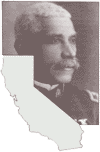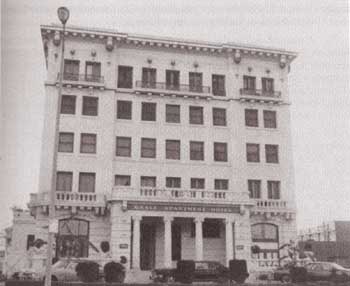![]()

Five Views: An Ethnic Historic Site Survey for California
MENU
Introduction
A.M.E. Church
Education
![]() Industry
Industry
Farming
Business
Associations
Noted Individuals
Historic Sites
Selected References

A History of Black Americans in California:
INDUSTRY
The California Legislature not only disenfranchised its Black citizens, but also enacted a fugitive slave law that jeopardized the status of free persons of color. Evidence derived from various court cases, manumission records, pioneers' personal documents, and legislative proceedings show that conditions of servitude existed for many Black Californians between 1848 and 1863. The conditions prevailed despite a constitutional provision which stipulated that "neither slavery or involuntary servitude, unless for the punishment of a crime shall ever be tolerated in the State." Even though the constitution prohibited the peculiar institution, it should be noted that an 1852 law provided for seizure of any person alleged to be a fugitive brought to the state before its admission to the Union. [11]On proof to the satisfaction of a magistrate of the court, the accused could be removed from the state. Under no circumstances could testimony of the alleged fugitive be admitted as evidence.
Official records indicate that this law was used to veil the intent of persons unlawfully holding others in involuntary servitude. The experience of Biddy Mason and Stephen Spencer Hill are two cases in point.
Despite their political disenfranchisement, Black people contributed to the development of three California industries before World War II: mining, lumber, and agriculture. Black miners could be found throughout the mining frontier — in the Mother Lode Country and in Southern California's gold mines. Historic place names in the gold region such as Negro Bar, Negro Flat, and Nigger Ravine are reminders of Black miners' presence and the racist behavior their presence evoked. Pejorative epithets such as these, commonly used in gold region place names, portray the hostile environment within which Black miners worked to secure their claims, protect their liberty, and guard against bodily harm. Without the right to testify against Whites, these miners had only their genius, brawn, and comrades to protect them from White miners' encroachments.
Individual Blacks, free and slave, worked alongside Whites, while others worked in company with fellow Black miners. Kentucky Ridge Mine, near Bidney Springs in Nevada County, operated for two years (1851 and 1852) by a large number of slaves, has acquired virtual legendary status. A colony of Black men and women settled along Deer Creek in 1851 to work the Kentucky Ridge Mine. These Afro-Americans came to Nevada County from Georgia as the slaves of Colonel William F. English. English reportedly was a Georgia planter who sold his plantation in 1850, then journeyed to Philadelphia, where he purchased a ship to transport machinery and workers to California to establish a mining enterprise.
Organized mining companies formed by Afro-Americans operated some profitable mining claims. A Black concern owned Horncut Mine, a prosperous quartz claim in Brown's Valley, the town near Marysville in Yuba County that became prominent for its rich surface diggings and extensive quartz mines. Another Black mining concern, the Rare Ripe Gold and Silver Mining Company, also located in Brown's Valley was, according to an article in the San Francisco Elevator, 1868, a "first class" company (a noteworthy comment, since quartz mining required heavy machinery, and few men had the investment capital to properly outfit that kind of mining operation).
Outside Stockton, San Joaquin County, Mose Rodgers, in company with other Black men, owned several successful mining companies. Rodgers best-known mine, and one for which he was a stockholding superintendent, was the Washington Mine, established in 1869. In certain years, more than half a million dollars in gold was taken out of the Washington Mine. A mining tycoon and technical genius, Rodgers was constantly sought after for his knowledge of mining technology.
Gold was discovered in San Diego County in 1869 by a Black man, Frederick Coleman. Coleman made the discovery near Julian, in a creek that now bears his name. Thousands swarmed to the area as news of the discovery spread, radically changing the quiet settlement that had originally been established by Blacks and Indians. A town government was installed, and the place was renamed to commemorate the Julian brothers, Mike and Webb, former Confederate soldiers.
The ethnic character of the new town changed after the discovery of gold, but its Black population continued to increase. In fact, Julian continued to have the highest percentage of Black residents of any town in the county until 1900, and Black people continued to be represented in the commercial sector as the new town began to grow. Prominent among the entrepreneurs were Albert and Margaret Robinson, who operated a restaurant in the 1870s and later expanded it to include a hotel. The Robinson Hotel, operated under family management until 1921, is now the town's only hotel.
Black mill workers from the old South were a principal labor force in the wood products industry in at least three counties between 1920 and 1960. Experienced Black mill workers recruited directly from the South are known to have migrated to lumber towns in Plumas and Siskiyou counties in the 1920s, and in Placer County in the 1940s. Weed and Foresthill are two lumber towns that serve as examples of Afro-Americans' critical participation in the industry. McCloud and a number of other towns share a similar history. Further examination of this facet of the lumber industry could contribute a great deal toward an understanding of a significant pattern of labor history.
Black settlements were established in Quincy and Weed during the 1920s by Louisiana-based sawmill companies that purchased existing California mills and recruited experienced workers from communities adjacent to the parent company's home operation. Transportation costs were advanced, and housing was guaranteed for those willing to relocate.
In the 1920s, when Southern Black mill workers entered the California lumber industry's labor force, racial discrimination was flagrant throughout the industry. The employment structure limited Black men to non-supervisory positions. Although they were indispensable to the mills' operation, their compensation and status were never commensurate to their work. Their responsibilities ranged from highly skilled operations to the most dangerous, and some mills were manned by virtually all Black crews that performed all but supervisory functions. It was not until quite recently that Black men have been elevated to the position of foreman.

Grace Apartments, Los Angeles County
NEXT> Farming
Last Modified: Wed, Nov 17 2004 10:00:00 pm PDT
5views/5views2c.htm
 Top
Top